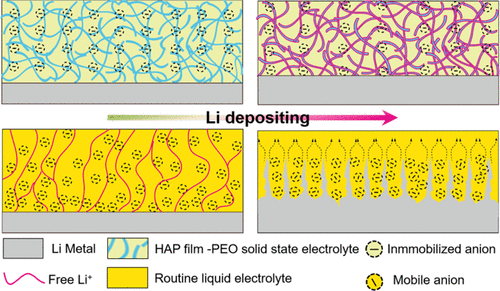当前位置:
X-MOL 学术
›
ACS Appl. Mater. Interfaces
›
论文详情
Our official English website, www.x-mol.net, welcomes your
feedback! (Note: you will need to create a separate account there.)
Hydroxyapatite Nanowire-Reinforced Poly(ethylene oxide)-Based Polymer Solid Electrolyte for Application in High-Temperature Lithium Batteries
ACS Applied Materials & Interfaces ( IF 8.3 ) Pub Date : 2020-11-23 , DOI: 10.1021/acsami.0c15692 Jie Wen 1 , Rui Zhang 2 , Qiannan Zhao 1 , Wei Liu 1 , Guanjie Lu 1 , Xiaolin Hu 1 , Jing Sun 3 , Ronghua Wang 1, 3 , Xiaoping Jiang 1 , Ning Hu 1 , Jilei Liu 2 , Xingjiang Liu 4 , Chaohe Xu 1
ACS Applied Materials & Interfaces ( IF 8.3 ) Pub Date : 2020-11-23 , DOI: 10.1021/acsami.0c15692 Jie Wen 1 , Rui Zhang 2 , Qiannan Zhao 1 , Wei Liu 1 , Guanjie Lu 1 , Xiaolin Hu 1 , Jing Sun 3 , Ronghua Wang 1, 3 , Xiaoping Jiang 1 , Ning Hu 1 , Jilei Liu 2 , Xingjiang Liu 4 , Chaohe Xu 1
Affiliation

|
Hybrid polymer electrolytes with excellent performance at high temperatures are very promising for developing solid-state lithium batteries for high-temperature applications. Herein, we use a self-supporting hydroxyapatite (HAP) nanowire membrane as a filler to improve the performance of a poly(ethylene oxide) (PEO)-based solid-state electrolyte. The HAP membrane could comprehensively improve the properties of the hybrid polymer electrolyte, including the higher room-temperature ionic conductivity of 1.05 × 10–5 S cm–1, broad electrochemical windows of up to 5.9 V at 60 °C and 4.9 V at 160 °C, and a high lithium-ion migration of 0.69. In addition, the LiFePO4//Li full battery with a solid electrolyte possesses good rate capability, cycling, and Coulomb efficiency at extreme high temperatures, that is, after 300 continuous charge and discharge cycles at 4 C rate, the discharge capacity retention rate is 77% and the Coulomb efficiency is 99%. The use of the flexible self-supporting HAP nanowire membrane to improve the PEO-based solid composite electrolyte provides new strategies and opportunities for developing rechargeable lithium batteries in extreme high-temperature applications.
中文翻译:

羟基磷灰石纳米线增强聚环氧乙烷基聚合物固体电解质在高温锂电池中的应用
在高温下具有优异性能的混合聚合物电解质对于开发用于高温应用的固态锂电池非常有前途。在本文中,我们使用自支撑羟基磷灰石(HAP)纳米线膜作为填料,以提高基于聚环氧乙烷(PEO)的固态电解质的性能。HAP膜可以全面改善混合聚合物电解质的性能,包括更高的室温离子电导率1.05×10 –5 S cm –1,宽的电化学窗口(60°C时高达5.9 V,160°C时高达4.9 V) °C,且锂离子迁移率为0.69。此外,LiFePO 4//带有固体电解质的锂离子充满电电池在极高的温度下具有良好的倍率性能,循环性能和库仑效率,也就是说,在4 C速率下进行300次连续充电和放电循环后,放电容量保持率为77%,库仑效率为99%。柔性的自支撑HAP纳米线膜的使用,以改善基于PEO的固体复合电解质,为在极端高温应用中开发可充电锂电池提供了新的策略和机会。
更新日期:2020-12-09
中文翻译:

羟基磷灰石纳米线增强聚环氧乙烷基聚合物固体电解质在高温锂电池中的应用
在高温下具有优异性能的混合聚合物电解质对于开发用于高温应用的固态锂电池非常有前途。在本文中,我们使用自支撑羟基磷灰石(HAP)纳米线膜作为填料,以提高基于聚环氧乙烷(PEO)的固态电解质的性能。HAP膜可以全面改善混合聚合物电解质的性能,包括更高的室温离子电导率1.05×10 –5 S cm –1,宽的电化学窗口(60°C时高达5.9 V,160°C时高达4.9 V) °C,且锂离子迁移率为0.69。此外,LiFePO 4//带有固体电解质的锂离子充满电电池在极高的温度下具有良好的倍率性能,循环性能和库仑效率,也就是说,在4 C速率下进行300次连续充电和放电循环后,放电容量保持率为77%,库仑效率为99%。柔性的自支撑HAP纳米线膜的使用,以改善基于PEO的固体复合电解质,为在极端高温应用中开发可充电锂电池提供了新的策略和机会。

















































 京公网安备 11010802027423号
京公网安备 11010802027423号